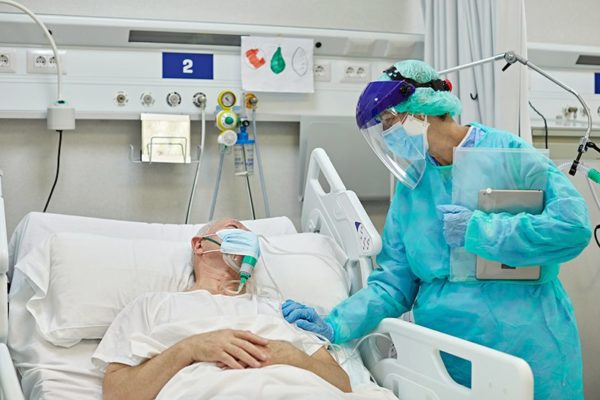The number of COVID-positive patients in Los Angeles County hospitals has decreased to 649, down from 658 the previous day, according to the latest state numbers released Saturday.
Of those patients, 77 were being treated in intensive care, down from 81 on Friday.
Some of the patients were initially hospitalized for other reasons and learned they had COVID after a mandated test.
The latest figures come one day after local health officials reported another 14 virus-related deaths and 1,343 new positive cases. The new fatalities brought the county’s cumulative total from throughout the pandemic to 35,734, while the county’s case total now stands at 3,708,022, according to the Los Angeles County Department of Public Health.
Daily case numbers released by the county are undercounts of actual virus activity in the county, due to people who use at-home tests and don’t report the results, and others who don’t test at all.
The county’s test positivity rate was holding steady at 5.6%, about the same as a week ago.
With local emergency declarations on COVID-19 set to end on the final day of March, the county health department is reminding residents the virus remains a concern — and that people should “continue taking sensible steps to protect themselves and others against severe illness and help keep hospitalization and death rates low.”
“At Public Health, we are acutely aware that the pandemic is not over and that there are people within our county who continue to feel the hardships of COVID-19 every day,” Barbara Ferrer, director of the LA County Department of Public Health, said in a statement Thursday.
“As we enter this new phase, residents of Los Angeles County are reminded that there is no change in their access to lifesaving tools. We will work with federal and state officials in the coming weeks and months to make sure this remains true. Vaccines, therapeutics and testing are the resources that got us to this place where there is less severe illness from COVID, and this is where we hope to stay.”
Ferrer’s comments came two days after the LA County Board of Supervisors agreed to end the county’s local COVID emergency declarations at the end of March — while also warning that the move does not mean the virus no longer poses a threat.
“Yes, COVID-19 is still with us,” Supervisor Hilda Solis said. “No, we don’t want to abandon those tools that got us to this place … but with effective vaccines and testing abundantly available we can move on to the next phase of our response to COVID-19.”
The board voted unanimously in support of Supervisor Janice Hahn’s motion, which will end the proclamation of a local emergency and the proclamation of a local health emergency on March 31. The board’s decision came on the day the statewide COVID emergency declaration ended.
Hahn noted in her motion that the emergency declarations “saved lives and protected the health of county residents.” But it noted that, thanks to the widespread availability of vaccines, therapeutics and other measures to combat virus spread and illness, “hospitalizations and deaths due to COVID-19 have dramatically reduced.”
Meanwhile, the health department Thursday highlighted various data regarding the effectiveness of the updated bivalent booster, which was formulated to protect against Omicron strains. Among the points were:
— for the 30-day period ending Feb. 14, vaccinated people in LA County who had not received the bivalent booster were 1.5 times more likely to be hospitalized than were people who received the updated bivalent booster;
— unvaccinated people were five times more likely to be hospitalized compared to people who had received the bivalent booster;
— for the 30-day period ending Feb. 7, unvaccinated residents were over six times more likely to die compared to people who had received the bivalent booster, while people who had been vaccinated but did not receive the updated bivalent booster were more than 1.5 times more likely to die from a COVID-19 infection than those who were boosted.
For the seventh straight week, LA County remained in the U.S. Centers for Disease Control and Prevention’s “low” community level.
According to county data, the latest seven-day case rate stood at 62 new cases per 100,000 people — a decrease from the 69 new cases per 100,000 people a week earlier.
The seven-day total for new COVID-19 hospital admissions per 100,000 people was 6.9, about the same as the previous week’s 7.0 figure.
The health department also said that the seven-day average of staffed inpatient hospital beds was at 3.8% for COVID patients, down a hair from the previous week’s 3.9%.
Lifting the emergency declarations does not automatically mean that all COVID-related restrictions will immediately go away. Ferrer said last week her agency will be reviewing existing health officer orders, noting that some of the requirements in them were enacted under the county’s emergency declaration, but others were not.
“So by the end of March, some of the health officer orders that were written here in LA County by Dr. (Muntu) Davis (the county health officer), would in fact need to be changed if they are going to continue, because some of them were done under an emergency declaration,” Ferrer said. “There are other health officer orders that aren’t done under emergency declaration. …
“A health officer always has authority to mitigate the impact of communicable diseases,” she said.
One of the mandates set to be lifted is a requirement that people who are exposed to COVID-19 wear a mask for 10 days. Ferrer said public health officials will be reviewing data to determine whether that requirement will continue under a revised health order.
Ferrer noted that some requirements — such as mandatory mask-wearing at health care facilities — are state orders, not county.
“We’re anxiously awaiting like everyone else if there are going to be changes there,” she said.







